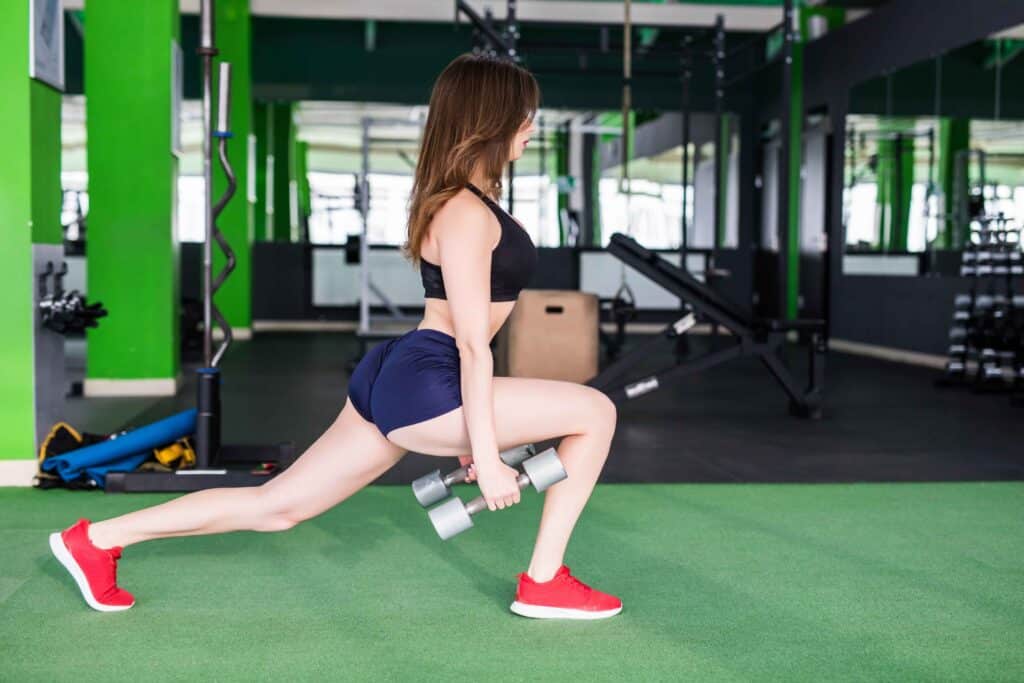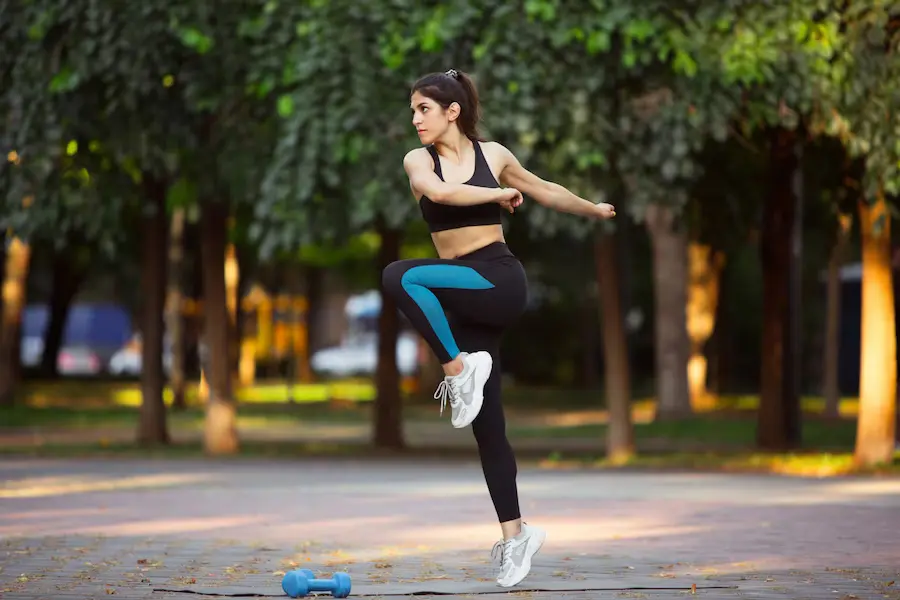Do you struggle to find effective back exercises that yield real results? If so, look no further; With compound back exercises, typically involving more than one joint and several different muscle groups, you can get the sculpted shape you have been desiring.
Not only are these types of movements great for building strength and power, but they also help promote muscular endurance too.
Read on to learn more about how to maximize your workouts with compound back exercises:
Best Compound Back Workouts For Mass
These compound back workouts are sure to add mass to your back:
1. Lat Pulldown
Lat pulldowns are an excellent compound exercise for building a strong and well-defined back, particularly targeting the latissimus dorsi muscles, which create the desirable V-taper physique.
The exercise also engages the rhomboids, rear deltoids, and middle traps, contributing to improved posture and back strength.
By mastering lat pulldowns, you enhance your ability to perform other pulling movements like pull-ups and rows, making it a crucial exercise for overall upper body development.
Step-By-Step Guide
- Sit on the lat pulldown machine with your thighs secured under the thigh pads and adjust the knee pad height for comfort and stability.
- Grasp the wide bar with an overhand grip slightly wider than shoulder-width apart.
- Before starting, take a deep breath and engage your core for stability throughout the exercise.
- Initiate the movement by pulling the bar down towards your upper chest, focusing on contracting your lats and squeezing your shoulder blades together.
- Exhale as you pull the bar down and keep your elbows pointing downwards, not flaring out to the sides.
- Pause for a moment when the bar reaches your chest to maximize the engagement of your back muscles.
- Slowly and under control, extend your arms back to the starting position without fully locking your elbows.
- Inhale as you return to the starting position and repeat for the desired number of repetitions.
Mistakes To Avoid
- Avoid using excessive momentum or jerking the weight down. Emphasize controlled movements to ensure proper muscle activation.
- Don’t arch your back excessively or lean back during the exercise. Keep your torso upright and stable throughout the movement.
- Avoid a grip that is too wide or too narrow, as it can strain the shoulders and wrists. Opt for a comfortable grip width.
2. Seated Cable Row
Seated cable rows are an effective compound exercise for targeting the lats, rhomboids, rear deltoids, and middle traps, providing a comprehensive back workout.
The exercise also engages the biceps and forearms, contributing to overall upper-body strength and muscular development.
Incorporating seated cable rows into your routine can improve posture, reduce the risk of back injuries, and enhance pulling strength for various daily activities and sports.
Step-By-Step Guide
- Sit on a rowing machine with your feet placed against the footrests and your knees slightly bent.
- Grasp the handle attachments with an overhand grip (palms facing down) at shoulder-width apart.
- Sit tall with your chest up, shoulders relaxed, and maintain a natural arch in your lower back.
- Before starting the movement, engage your core and pull your shoulder blades back and down.
- Initiate the row by pulling the handles towards your abdomen, focusing on using your back muscles rather than your arms.
- Exhale as you pull, squeezing your shoulder blades together at the end of the movement for maximum contraction.
- Hold the squeezed position for a moment to enhance the benefits.
- Slowly and with control, extend your arms back to the starting position without rounding your back.
- Inhale as you return to the starting position and repeat for the desired number of repetitions.
Mistakes To Avoid
- Avoid rounding your back or hunching your shoulders during the exercise. Maintain a tall and upright posture throughout.
- Don’t use your lower back to generate momentum; the movement should be initiated and powered by the back muscles.
- Avoid pulling the handles too far back, as it can lead to strain on the shoulder joint. Focus on a controlled range of motion.
3. Cable Trap Shrug
Cable trap shrugs primarily target the trapezius muscles responsible for shoulder elevation and neck stability.
The exercise also engages the levator scapulae and rhomboids, supporting upper back strength and posture.
By incorporating compound back movement into your routine, you can reduce tension and pain in the neck and shoulders while promoting shoulder girdle stability.
Step-By-Step Guide
- Stand in front of a cable machine with the pulley set at the lowest position.
- Grasp the handle attachments with an overhand grip (palms facing your body) at shoulder-width apart.
- Stand tall with your chest up, shoulders relaxed, and feet positioned shoulder-width apart.
- Before starting the movement, engage your core for stability.
- Elevate your shoulders towards your ears in a controlled manner, focusing on engaging your traps.
- Exhale as you perform the shrug, ensuring your shoulders move in a straight line without rolling forward or backward.
- Hold the top position for a moment to intensify the muscle contraction.
- Lower your shoulders back down in a controlled manner, fully extending your arms.
- Inhale as you return to the starting position and repeat for the desired number of repetitions.
Mistakes To Avoid
- Avoid using excessive weight; the focus should be on controlled movements and isolating the traps.
- Don’t roll your shoulders forward or backward during the exercise. Maintain a vertical path during the shrug.
- Avoid shrugging too forcefully, as it can lead to neck strain. Focus on smooth and controlled movements.
Compound Back Exercises At Home
Do these exercises at home, and say hello to your dream back:
4. Inverted Row
Inverted rows are a fantastic bodyweight compound back exercise that targets the upper and middle back muscles, including the rhomboids, rear deltoids, and lower traps.
They also use the biceps and forearms as stabilizers, promoting upper body strength and stability.
Inverted rows help correct rounded shoulders and improve posture by strengthening the muscles that support the spine.
Step-By-Step Guide
- Set up a barbell in a squat rack or use suspension straps attached to a sturdy anchor point at waist height.
- Lie on your back underneath the bar or handles, with your arms fully extended and grasping the bar or handles.
- Position your feet flat on the ground, hip-width apart, and keep your knees slightly bent for stability.
- Before initiating the movement, engage your core and glutes to maintain a straight line from your head to your heels.
- Begin pulling your chest up towards the bar or handles by retracting your shoulder blades and squeezing them together.
- Exhale as you pull your body upwards, keeping your elbows close to your sides throughout the movement.
- Hold the top position for a moment to maximize back muscle activation.
- Lower your body back down in a controlled manner, fully extending your arms.
- Inhale as you return to the starting position and repeat for the desired number of repetitions.
Mistakes To Avoid
- Avoid sagging your hips or allowing your body to form a banana-like shape. Keep your body straight and aligned throughout the exercise.
- Don’t rush the movement or use excessive momentum to complete repetitions. Focus on slow and controlled movements for optimal muscle engagement.
- Avoid shrugging your shoulders towards your ears; instead, keep them relaxed and away from your ears to target the back muscles effectively.
5. T-Bar Row
T-bar rows are an excellent compound exercise for targeting the middle back, including the rhomboids, rear deltoids, and lower traps.
The exercise also engages the lats, biceps, and forearms as stabilizers, providing a well-rounded upper-body workout.
Step-By-Step Guide
- Stand with your feet shoulder-width apart, facing the end of a T-bar row machine.
- Bend at the hips to grip the handles or bar with both hands, palms facing each other.
- Before initiating the movement, engage your core and maintain a flat back.
- Position your knees with a slight bend to allow for a stable and strong stance.
- Begin the row by pulling the handles or bar towards your abdomen, focusing on driving your elbows back.
- Exhale as you pull, squeezing your shoulder blades together at the peak of the movement.
- Hold the contracted position for a moment to intensify the muscle engagement.
- Lower the weight back down with control until your arms are fully extended.
- Inhale as you return to the starting position and repeat for the desired number of repetitions.
Mistakes To Avoid
- Don’t use your lower back to lift the weight; focus on initiating the movement with your back muscles.
- Avoid excessive swinging or using momentum to complete repetitions. Emphasize controlled movements throughout the exercise.
Value-Driven Approach
Compound back exercises play a crucial role in overall strength, aesthetics, and functional fitness. By consistently incorporating these exercises into your training routine, you can experience a multitude of benefits:
- Improved Posture: A strong back helps maintain proper alignment and reduces the risk of rounded shoulders or a hunched posture.
- Enhanced Upper Body Strength: Compound back exercises engage multiple muscle groups, promoting overall upper body strength.
- Functional Fitness: The back muscles play a vital role in daily activities like lifting, carrying, and pulling, making these exercises essential for functional fitness.
- Reduced Risk of Injuries: Strengthening the back muscles enhances spinal support and stability, reducing the likelihood of back-related injuries.
- Aesthetics: Compound back exercises contribute to a well-defined and balanced physique, creating an appealing V-taper shape.
Final Verdict
As you can see, compound back exercises are great for building strength and improving overall fitness and are an incredibly fun way to work out.
And the best part? Everybody can benefit from these exercises whether you’re a beginner or an expert.
So, if you ever feel stuck in your workout routine, why not try compound back exercises? You won’t regret it.
So don’t wait–change up your routine today and follow us for more workouts and fitness tips.










